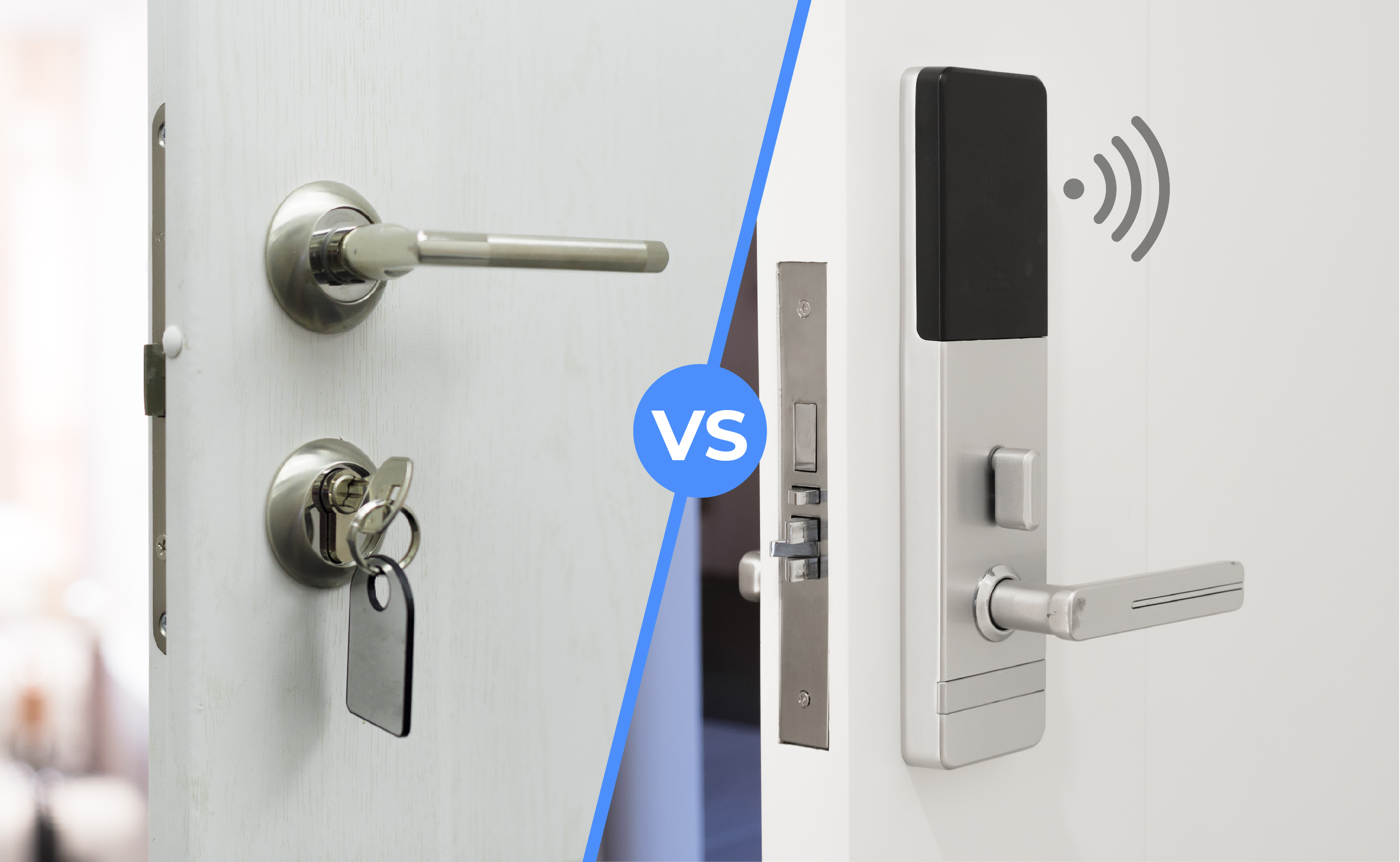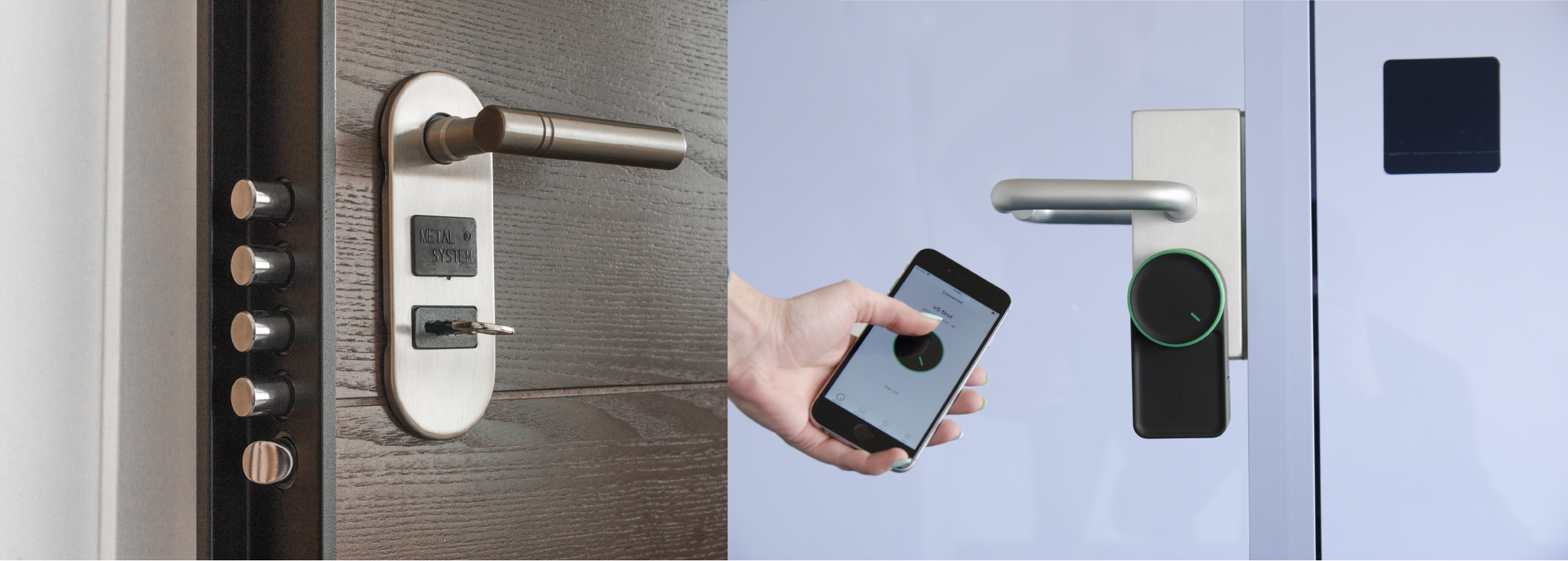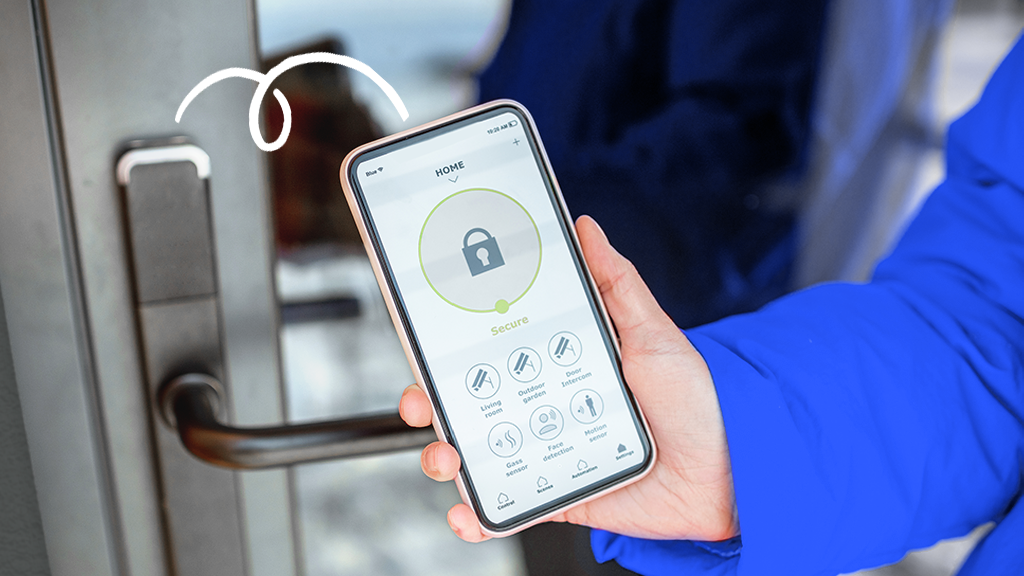Smart locks offer enhanced security features such as fingerprint recognition and facial recognition, giving them an edge over traditional key locks. Additionally, smart locks can be locked and unlocked from anywhere, providing added convenience and security.
Table of Contents
As technology continues to advance, smart locks are increasingly being used as a home security enhancement. With their innovative features and remote access capabilities, smart locks are proving to be a safer and more secure option compared to traditional key locks.
Introduction To Smart Locks And Traditional Key Locks
Smart locks offer advanced security features like fingerprint recognition and two-factor authentication, providing enhanced safety compared to traditional key locks. Additionally, smart locks can be locked and unlocked remotely, while traditional locks require a physical key, making smart locks a more convenient and secure option for modern homeowners.
When it comes to securing your home, the type of lock you choose plays a crucial role. Smart locks and traditional key locks are two popular options, each with its unique features and benefits. In this blog post, we will explore the evolution of locks, compare their convenience, and ultimately determine which is safer for your home.
Evolution Of Locks
Locks have come a long way from traditional key and tumbler designs to the modern, high-tech smart locks of today. The evolution of locks has been driven by the need for improved security, convenience, and ease of use. Smart locks, equipped with advanced features like biometric access and remote control, represent the latest innovation in home security technology.
Comparing Convenience
When it comes to convenience, smart locks offer a range of features that traditional key locks simply cannot match. With smart locks, you can easily control and monitor access to your home remotely, grant temporary access to guests, and receive real-time alerts on your smartphone. On the other hand, traditional key locks require physical keys, which can be lost or stolen, leading to potential security risks.
Mechanics Of Smart Locks
Smart locks offer advanced security features such as fingerprint recognition and two-factor authentication, making them a safer option than traditional key locks. With smart locks, there is no risk of lock picking, and the built-in backup system prevents unauthorized access.
Overall, smart locks provide enhanced security and peace of mind for homeowners.
How Smart Locks Work
Smart locks utilize technology such as Bluetooth or Wi-Fi to communicate with your smartphone, allowing you to lock and unlock your door remotely.
They often have a companion app that lets you control access, view activity logs, and receive notifications.
Key Features Of Smart Locks
- Remote access and control via smartphone
- Activity logs and notifications
- Integration with smart home systems
- Advanced security features like fingerprint or facial recognition
Mechanics Of Traditional Key Locks
The mechanics of traditional key locks involve the use of physical keys to unlock doors or other entry points. While these locks have been around for centuries, the rise of smart locks has sparked a debate about which is safer.
Smart locks offer advanced security features such as facial recognition and two-factor authentication, but traditional locks are still considered reliable and difficult to pick. Ultimately, the choice between the two will depend on individual security needs and preferences.
The mechanics of traditional key locks are based on a simple principle – the lock is secured by a physical key that is inserted into a keyhole. When the correct key is inserted, the internal pins of the lock align, allowing the lock to turn and open. This mechanical process is what makes traditional key locks so popular and widely used. However, it is important to note that traditional key locks have limitations in terms of security, especially if the key is lost or stolen.
Also read: Best Wireless Front Door Locks For Your Home
How Key Locks Work
The mechanism of key locks is straightforward to understand. The key is inserted into the keyhole, which has a series of pins that align with the grooves of the key. When the correct key is inserted, the pins align and the lock can be turned to open. However, if the wrong key is used or if the pins do not align correctly, the lock will not turn. This simple mechanism has been used for hundreds of years and is still widely used today.
Standard Lock Features
Most traditional key locks have standard features that include a keyhole, pins, and a lock cylinder. The keyhole is where the key is inserted, and the pins are what align with the grooves of the key. The lock cylinder is the part of the lock that contains the pins and is where the key is inserted. These standard lock features are what make traditional key locks so simple and easy to use.
Overall, traditional key locks are a popular and simple way to secure doors and other entry points. However, they do have limitations in terms of security, especially if the key is lost or stolen. For those looking for enhanced security features, smart locks may be a better option.

Credit: reolink.com
Security Features Of Smart Locks
When it comes to ensuring the safety of your home, the security features of smart locks play a crucial role. These advanced locking systems offer a range of features that provide enhanced security compared to traditional key locks.
Biometric And Access Codes
Smart locks are equipped with advanced biometric technology, such as fingerprint recognition and facial recognition, offering a highly secure method of access. Additionally, users can create unique access codes for family members, friends, or trusted individuals, allowing controlled entry to the premises.
Remote Control And Alerts
One of the key security advantages of smart locks is the ability to remotely control and monitor access to your home. Through a dedicated mobile app, homeowners can lock or unlock the door from anywhere, as well as receive real-time alerts regarding any unauthorized attempts or suspicious activities.
Vulnerabilities Of Smart Locks
Smart locks have revolutionized the way we secure our homes, offering convenience and advanced security features. However, they are not without their vulnerabilities. It’s essential to understand the potential risks associated with smart locks to make an informed decision about home security.
Battery Dependency
One of the primary vulnerabilities of smart locks is their dependency on batteries. Smart locks are battery-operated devices, and if the batteries are not regularly checked and replaced, they can fail unexpectedly, leaving your home vulnerable to unauthorized access.
Digital Hacking Risks
Unlike traditional key locks, smart locks are susceptible to digital hacking. As smart locks are connected to the internet or operate using wireless technology, they can be targeted by cybercriminals who may attempt to exploit security vulnerabilities to gain unauthorized access to your home.
Security Features Of Traditional Locks
Traditional locks offer basic security features like key access and deadbolts. However, smart locks provide advanced options such as fingerprint or facial recognition and two-factor authentication, making them more secure against picking. Smart locks offer enhanced security features compared to traditional locks, improving overall safety.
Physical Robustness
Traditional locks are made of metal, which makes them physically robust and durable. They are designed to withstand forceful entry, making them a great choice for securing your home. Traditional locks come in different shapes and sizes, and some even have additional features like deadbolts and anti-drill plates that make them even more secure. The physical robustness of traditional locks ensures that they are difficult to break into, giving you peace of mind that your home is well-protected.
Lack Of Digital Exploits
Unlike smart locks, traditional locks lack digital exploits. They do not rely on software or electronic components to function, which means they cannot be hacked or tampered with remotely. This makes them less vulnerable to cyberattacks and ensures that they provide reliable security for your home. With traditional locks, you do not have to worry about hackers gaining access to your home or compromising your security system.
Overall, while smart locks have advanced features that make them convenient to use, traditional locks offer physical robustness and lack digital exploits, making them a safer choice for securing your home. It is important to weigh the pros and cons of both types of locks before making a decision.
Vulnerabilities Of Traditional Locks
Lock Picking And Bumping
Traditional locks are susceptible to lock picking and bumping techniques, making them vulnerable to intruders. Lock picking involves manipulating the pins inside the lock to open it without a key while bumping uses a specially crafted key to force the lock open.
Lost Or Stolen Keys
One of the major weaknesses of traditional locks is the risk of lost or stolen keys. If a key falls into the wrong hands, unauthorized access to your property becomes a real threat. Replacing the locks can be costly and time-consuming.
Comparative Analysis Of Lock Tampering
When comparing smart locks and traditional key locks, it’s essential to consider the aspect of lock tampering. Understanding the comparative analysis of lock tampering can provide valuable insights into the safety and security offered by each type of lock.
Picking Resistance
Smart locks offer advanced picking resistance due to their electronic mechanisms, making them significantly more challenging to manipulate compared to traditional key locks. The lack of physical key access in smart locks eliminates the vulnerability to traditional picking methods, enhancing overall security.
Forced Entry Considerations
Smart locks provide enhanced forced entry considerations by incorporating features such as built-in backup systems and multiple authentication methods, including biometrics and unique access codes. These advanced security measures make it exceedingly difficult for intruders to force their way into a property compared to traditional key locks.
User Experience With Smart Locks
When comparing smart locks to traditional key locks, the user experience with smart locks reveals enhanced security features such as fingerprint recognition and two-factor authentication. Smart locks provide convenience and advanced security, making them a safer option compared to traditional key locks.
Ease Of Use
Smart locks offer a seamless user experience with convenient features like remote access and keyless entry.
Traditional key locks require physical keys and can be cumbersome to manage, especially when keys are lost or misplaced.
Smart Home Integration
Smart locks easily integrate with smart home systems, allowing users to control access from their smartphones.
Traditional key locks do not offer the same level of integration with smart home technology.
User Experience With Traditional Locks
When it comes to user experience, traditional locks offer a sense of familiarity and reliability that many people appreciate. Let’s delve into the key aspects that make traditional locks stand out:
Tactile Reliability
Traditional locks provide tactile feedback that gives users a physical confirmation of locking or unlocking their doors. This hands-on experience can instill a sense of security and control.
No Tech Know-how Needed
With traditional key locks, there’s no need for any technical knowledge or troubleshooting. It’s a straightforward process of inserting the key and turning the lock, making it accessible for users of all ages.
Cost-benefit Analysis
When it comes to deciding between smart locks and traditional key locks, it’s essential to consider the cost-benefit analysis. Understanding the initial and recurring costs as well as the long-term investment value can help you make an informed decision about which type of lock is safer for your home or business.
Initial And Recurring Costs
Let’s start by examining the initial and recurring costs associated with smart locks and traditional key locks:
| Smart Locks | Traditional Key Locks | |
|---|---|---|
| Initial Installation | Requires purchase of smart lock system and professional installation | Cost of purchasing and installing the lock and key system |
| Recurring Maintenance | Minimal maintenance is required, and occasional battery replacement | Regular maintenance of mechanical components, key duplication costs |
| Security Upgrades | May require software updates or additional security features | Limited options for security enhancements |
While the initial installation cost of smart locks may be higher, the recurring maintenance and security upgrade costs are generally lower compared to traditional key locks. It’s important to consider these factors when evaluating the cost-benefit analysis.
Long-term Investment Value
Now, let’s explore the long-term investment value of smart locks versus traditional key locks:
- Enhanced Security Features: Smart locks often come with advanced security features like fingerprint recognition, facial recognition, or two-factor authentication, providing a higher level of security compared to traditional locks.
- Durability and Lifespan: Smart locks are designed to be durable and have a longer lifespan, reducing the need for frequent lock replacements.
- Convenience and Accessibility: Smart locks offer remote access and monitoring capabilities, adding convenience and accessibility for homeowners and businesses.
Considering the enhanced security features, durability, and convenience offered by smart locks, they can be viewed as a long-term investment in the safety and security of your property.

Credit: keymitt.com
Privacy Concerns
When it comes to privacy concerns, both smart locks and traditional key locks have their own set of considerations. Let’s delve into the data collection aspects and anonymity features of each type of lock.
Data Collection In Smart Locks
Smart locks often raise privacy concerns due to their data collection capabilities. These locks may gather information such as lock usage patterns, entry and exit times, and even user identities. The data collected by smart locks could potentially be accessed by the lock manufacturer or third-party service providers, raising questions about the security and privacy of the information being collected.
Anonymity With Traditional Locks
On the other hand, traditional key locks offer a level of anonymity as they do not collect any personal data. With these locks, there are no concerns about data being transmitted to external parties or stored in a cloud-based system. The lack of data collection in traditional locks provides a sense of privacy and security for users who are cautious about the potential misuse of their personal information.
Emergency Access And Fail-safes
When it comes to emergencies and fail-safes, both smart locks and traditional key locks have their mechanisms in place to ensure access and security.
Backup Options For Smart Locks
- Smart locks offer backup options such as keypad entry codes or mobile app access.
- In case of a power outage, smart locks may have a physical key override for manual unlocking.
- Some smart locks also feature temporary access codes for guests or service providers.
Key Lock Redundancies
- Traditional key locks rely on physical keys for access, which can be duplicated or lost.
- Key lock redundancies include hiding spare keys or entrusting duplicates with trusted individuals.
- Rekeying traditional locks is a common practice for security purposes in case of key loss or theft.
Credit: www.thumbtack.com
Maintenance And Durability
When comparing smart locks and traditional key locks, it’s essential to consider the aspects of maintenance and durability. Both types of locks have their own set of requirements and vulnerabilities that can impact their longevity and overall security.
Battery Replacements
Smart locks operate on batteries, which need periodic replacement to ensure continuous functionality. Keeping track of battery levels and replacing them promptly is crucial to prevent lockouts due to power failure.
Wear And Tear Over Time
Traditional key locks are susceptible to wear and tear from frequent use, exposure to the elements, and potential physical damage. Over time, traditional locks may become less effective, requiring maintenance and repairs to maintain security.
The Role Of Smart Locks In Smart Homes
The Role of Smart Locks in Smart Homes
Home Automation Ecosystem
Smart locks play a crucial role in the home automation ecosystem, allowing homeowners to seamlessly integrate them into their smart homes. With the ability to connect to a centralized hub, such as a smart speaker or a dedicated home automation system, smart locks enable users to control access to their homes remotely.
Compatibility With Other Devices
One of the key advantages of smart locks is their compatibility with other smart devices. Whether it’s integrating with security cameras, motion sensors, or virtual assistants, smart locks offer a high level of interoperability within the smart home ecosystem, enhancing overall security and convenience.
Recovery From Lockouts
Smart Solutions
Smart locks offer convenient recovery options in case of lockouts:
- Remote unlocking via smartphone app
- Temporary access codes for trusted individuals
- Integration with virtual assistants for voice commands
Traditional Methods
When locked out with a traditional key lock, options are limited:
- Contacting a locksmith for assistance
- Attempting to pick the lock (requires skill and tools)
- Breaking a window or door as a last resort
Final Thoughts On Smart Locks vs. Traditional Key Locks
In the ongoing debate between smart locks and traditional key locks, the verdict on which is safer remains inconclusive. While smart locks offer advanced security features, traditional key locks are often seen as reliable due to their mechanical simplicity and proven track record.
Ultimately, the choice between the two comes down to personal preference and individual security needs.
Balancing Security And Convenience
When it comes to securing your home or business, there is always a trade-off between security and convenience. Traditional key locks offer a simple and reliable way to secure your property, but they require physical keys and can be vulnerable to picking and bumping. Smart locks, on the other hand, offer more advanced security features like fingerprint recognition and two-factor authentication, but they require power and connectivity and can be vulnerable to hacking and technical glitches.
Choosing The Right Lock For Your Needs
Ultimately, the choice between a smart lock and a traditional key lock comes down to your individual security needs and personal preferences. If you prioritize convenience and ease of use, a smart lock may be the best option for you. If you prioritize security and reliability, a traditional key lock may be the better choice.
Before making a decision, it’s important to do your research and evaluate the pros and cons of each type of lock. Consider factors like cost, installation, maintenance, and compatibility with your existing security system.
In conclusion, there is no one-size-fits-all answer to the question of whether smart locks or traditional key locks are safer. Both types of locks have their advantages and disadvantages, and it’s up to you to decide which one best meets your security needs and personal preferences.
Regardless of which type of lock you choose, it’s important to take steps to ensure that your property is as secure as possible. This may include installing additional security features like deadbolts, surveillance cameras, and motion sensors, as well as practicing good security habits like locking your doors and windows and keeping spare keys in a safe place.
Remember, the best way to ensure the security of your property is to stay informed, stay vigilant, and stay one step ahead of potential threats.
Frequently Asked Questions
Are Smart Locks Safer Than Key Locks?
Smart locks offer enhanced security with features like fingerprint recognition, facial recognition, and two-factor authentication, making them safer than key locks.
What Is The Safest Type Of Door Lock?
The safest type of door lock is the deadbolt, considered the most secure option. Smart locks also offer enhanced security features, such as fingerprint recognition and two-factor authentication, making them a strong alternative to traditional key locks.
Are Smart Locks Better Than Traditional Locks?
Smart locks offer enhanced security features like fingerprint recognition and two-factor authentication, making them more secure than traditional locks. Additionally, smart locks are harder to pick and can provide the convenience of remote access.
What Are The Disadvantages Of Smart Locks?
Smart locks rely on batteries which can die, making the lock inoperable if not monitored and maintained properly.
Are Smart Locks Safer Than Traditional Locks?
Smart locks offer advanced security features like biometric recognition, enhancing overall safety.
Can Traditional Deadbolts Be Easily Picked?
Traditional deadbolts can be picked, giving smart locks an advantage with their smart technology.
What Are The Key Benefits Of Smart Locks?
Smart locks provide convenience, security, and advanced features like biometric recognition.
While traditional key locks have their place, smart locks offer enhanced security features. Smart locks provide advanced options like fingerprint recognition and two-factor authentication, making them a safer choice for modern security needs. Consider the benefits of smart locks for a secure home.

